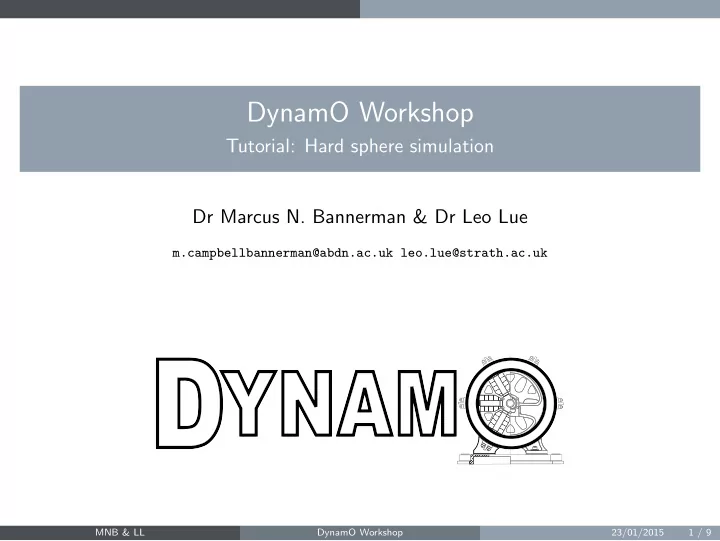

DynamO Workshop Tutorial: Hard sphere simulation Dr Marcus N. Bannerman & Dr Leo Lue m.campbellbannerman@abdn.ac.uk leo.lue@strath.ac.uk MNB & LL DynamO Workshop 23/01/2015 1 / 9
Hard-Sphere fluids Section Outline Hard-Sphere fluids Discovery of the entropic freezing transition Pressure Radial distribution function Equations of state Kinetic predictions of transport properties MNB & LL DynamO Workshop 23/01/2015 2 / 9
Hard-Sphere fluids Discovery of the entropic freezing transition ◮ Event-driven simulation of hard spheres was the first molecular dynamics simulation ever carried out, by Alder and Wainwright in 1957 1 . ◮ Their key result was that freezing may be driven entirely by entropic effects. ◮ They were able to see systems transitioning between liquid and solid states via the pressure, thanks to the speed of the algorithm and their use of small system sizes (32–500 particles). ◮ It wasn’t until 1967 2 , when Loup Verlet published his seminal paper on Lennard-Jones simulations ( N = 864), that continuous time-stepping approaches became popular. 1 B. J. Alder, T. E. Wainwright, “Phase Transition for a Hard Sphere System,” J. Chem. Phys. , 27 , 1208 (1957). 2 Loup Verlet, ”’Computer ”Experiments’ on Classical Fluids. I,” Phys. Rev. , 159 , 98 (1967). MNB & LL DynamO Workshop 23/01/2015 3 / 9
Hard-Sphere fluids Discovery of the entropic freezing transition MNB & LL DynamO Workshop 23/01/2015 4 / 9
Hard-Sphere fluids Discovery of the entropic freezing transition ∞ 1 . 0 ◮ The transition effect was suprising, as the hard sphere model has no intrinsic energy 0 . 5 U ( | r i − r j | ) scale. 0 . 0 ◮ This results in a trivial scaling of the system properties with temperature: Phase − 0 . 5 transitions cannot involve energetic considerations. − 1 . 0 ◮ This indicates that the stable crystal 0 . 8 0 . 9 1 . 0 1 . 1 1 . 2 1 . 3 1 . 4 1 . 5 structures of compounds are controlled by | r i − r j | the size of the molecules which make them Figure: A hard sphere potential up. where the diameter is σ = 1. MNB & LL DynamO Workshop 23/01/2015 5 / 9
Hard-Sphere fluids Pressure 30 25 20 ◮ The transition was first spotted as a p/ρ k B T 15 discontinuity in the pressure versus density curve (see right). 10 ◮ In molecular dynamics, points near transitions are liable to remaining in meta-stable states, therefore the 5 true coexistance densities cannot be immediately determined. 0 0 . 40 . 50 . 60 . 70 . 80 . 91 . 01 . 11 . 2 N σ 3 /V Figure: Pressure versus density for a hard sphere fluid of N = 1372 particles. Lines denote accurate values for the liquid/solid coexistance densities. MNB & LL DynamO Workshop 23/01/2015 6 / 9
Hard-Sphere fluids Radial distribution function ◮ To confirm that a system has indeed frozen, we might try to measure if there is local ordering around a particle. ◮ The radial distribution function, g ( r ), is a convenient function to analyse this. It is the average density of particles, relative to the bulk density, at a distance r from a particle. ◮ An example g ( r ) for high-density hard spheres is given below: 10 8 g(r / σ ) 6 4 2 0 1 1.5 2 2.5 3 3.5 4 4.5 5 r / σ Figure: Radial distribution function for ρ = 1 . 2, clearly displaying long-range √ √ ordering and peak locations characteristic for an FCC lattice ( r /σ = 1, 2, 3). ◮ Note: g ( r ) is discontinuous at r = σ . MNB & LL DynamO Workshop 23/01/2015 7 / 9
Hard-Sphere fluids Equations of state ◮ Finally, the hard sphere fluid is remarkable as we have a relatively strong theoretical descriptions of it. ◮ The fluid branch is accurately described by the Carnahan-Starling EOS: ρ k B T ≈ 1 + η + η 2 − η 3 p Z = (1) (1 − η ) 3 where η = N π σ 3 / 6 V is the packing fraction. ◮ The accuracy of these equations of state mean that the hard-sphere is often used as a reference system in thermodynamic perturbation theories which attempt to predict the thermodynamics of stepped and continuous potentials. ◮ The pressure in hard-spheres is also exactly linked to g ( r = σ + ) and the mean free time t mft : g ( σ + ) = 1 + 2 m σ √ π Z = 1 + 2 πρ σ 3 3 k B T t − 1 mft 3 ◮ These expressions can be generalised to stepped potentials 3 . 3 M. Bannerman, L. Lue “Exact on-event expressions for discrete potential systems,” J. Chem. Phys. , 133 , 124506 (2010) MNB & LL DynamO Workshop 23/01/2015 8 / 9
Hard-Sphere fluids Kinetic predictions of transport properties ◮ Boltzmann kinetic theory also provides simple expressions estimations for the transport properties for hard-sphere fluids at low density: D Enskog = 3 t mft 2 η Enskog = 5 ρ m D Enskog 6 λ Enskog = 25 ρ k B D Enskog 8 ◮ Enskog kinetic theory provides significantly more accurate expressions for the transport properties but the expressions are slightly more cumbersome. ◮ This is a very shallow introduction to the wide theoretical understanding of discrete potentials and, in particular, hard spheres. ◮ Enjoy the tutorial! MNB & LL DynamO Workshop 23/01/2015 9 / 9
Recommend
More recommend